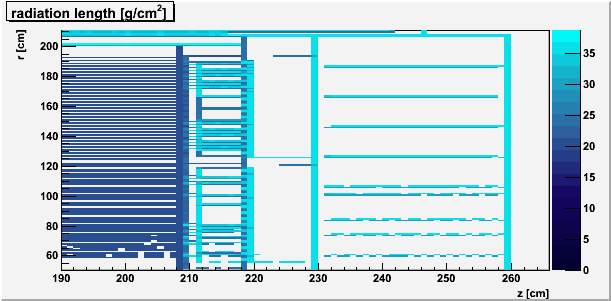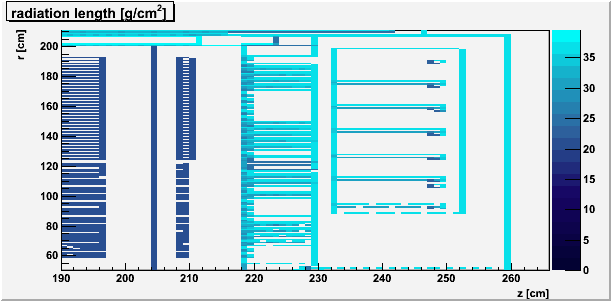Geometry Differential: y2006g + ECALv6 versus y2006g + ECALv6 + TPCE04
Abstract: The latest version of the TPC geometry is TPCE04. This geometry changes important features in the TPC structure, which account for ~1000 lbs. of material. We would like to incorporate these changes into the y2006 model of the STAR geometry. The simplest solution is to use TPCE04 in the y2006 geometry. However, this would replace the old TPC FEE setup (present in the TPCE03 geometry) with the new TPX electronics. In this study we investigate the impact on the material budget when using the TPCE04 option in the y2006 geometry.
Geantinos are thrown over the range -pi < theta < +pi, and -pi/72 < phi < pi/72 (aka +/- 5 degrees around 0).
Figure 1 -- Material composition in terms of radiation length. The radiation length of the material encountered by geantinos upon entering a volume is shown. Geometry is y2006g with TPCE03 and ECALv6.

Figure 2 -- Material composition in terms of radiation length. The radiation length of the material encountered by geantinos upon entering a volume is shown. Geometry is y2006g with TPCE04 and ECALv6.

Discussion: In the above plots, we have zoomed in on the region containing the TPC FEE. Several changes are apparent. (1) FEE cards are shorter in the TPCe04 geometry, (2) FEE cards for 60 < r < 80 are not present in new geometry, (3) support structures are shifted in z by ~10 cm,...
... so the distribution of material associated with TPC will change, as well as that associated with the TPC FEEs. It will be difficult to disentangle effects.
Groups:
- jwebb's blog
- Login or register to post comments
